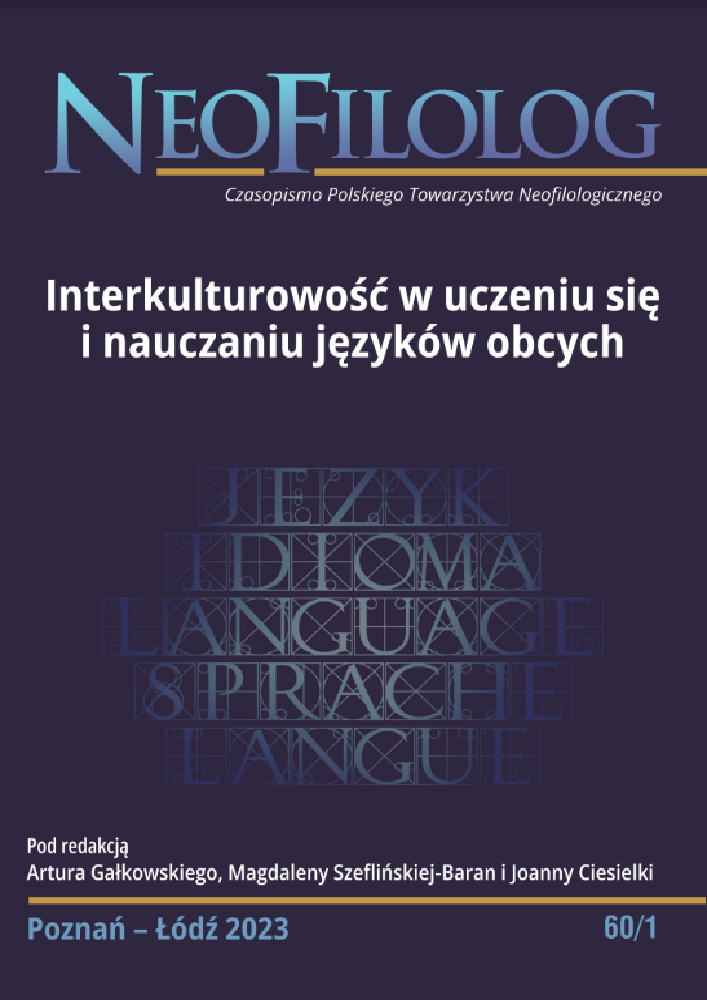Abstrakt
The topic of the article is phraseology analyzed from the perspective of didactics and translation. The author presents phraseology as a subject of research and shows its development over time. In the mid-twentieth century, the scope of phraseology mainly encompassed traditional, well-established expressions, such as pictorial phraseologisms, idioms or proverbs. At present, the concept of phraseology has grown significantly, and the research of phraseologists often focuses on structures not typical of traditional phraseology, such as, for example, collocations, multi-word specialist terminology, or reproducible conversational formulas, also known as pragmatemes. In the second part of the text, the author describes the research. Its aim was to find out to what extent philology students are familiar with frequently used pragmatemes. The study was conducted among students of Romance philology at the University of Silesia and covered 50 people. The study used 15 pragmatemes that are often used in modern French communication. The author presents a quantitative and qualitative analysis of the research. It also presents synthetic conclusions that are important in the context of didactics and translation.
Bibliografia
Chlebda W. (1989), Teoria frazeologiczna a nauczanie języka obcego. „Prace Językoznawcze”, nr 15, s. 96-108.
Chlebda W. (2003), Elementy frazematyki. Wprowadzenie do frazeologii nadawcy. Łask: Oficyna Wydawnicza Leksem.
Krzyżanowska A., Grossmann F., Kwapisz-Osadnik K. (red.) (2021), Les formules expressives de la conversation. Analyse contrastive : français-polonais-italien. Lublin: Wydawnictwo Episteme.
Lewicki A.M. (1976), Wprowadzenie do frazeologii syntaktycznej. Teoria związku frazeologicznego. Katowice: Prace Naukowe UŚ, nr 116.
Lewicki A.M. (1983), Składnia związków frazeologicznych. „Biuletyn PTJ”, z. XL, s. 75-83.
Lewicki A.M. (1999), Od przysłowia do frazeologizmu, (w:) Banyś W., Bednarczuk L., Karolak S. (red.), Studia Lingwistyczne ofiarowane prof. K. Polańskiemu na 70-lecie Jego Urodzin. Katowice: Wydawnictwo UŚ, s. 157-163.
Lewicki A.M. (2003), Studia z teorii frazeologii. Łask: Oficyna Wydawnicza Leksem.
Müldner – Nieckowski P. (2007), Frazeologia poszerzona. Warszawa: Oficyna Wydawnicza Volumen.
Skorupka S. (1969), Podstawy klasyfikacji jednostek frazeologicznych. „Prace Filologiczne”, v. XIX, s. 219-226.
Szutkowski T. (2019), Subkompetencja frazeologiczna studentów-neofilologów jako składnik kompetencji językowej tłumacza. Badanie pilotażowe. „Roczniki Humanistyczne”, t. LXVII, zeszyt 7, s. 93-111. DOI: https://doi.org/10.18290/rh.2019.67.7-6
Licencja
Prawa autorskie (c) 2023 Monika Sułkowska

Utwór dostępny jest na licencji Creative Commons Uznanie autorstwa – Bez utworów zależnych 4.0 Międzynarodowe.
Przedstawiany utwór (artykuł) upubliczniany jest na podstawie umowy z autorem i na licencji Creative Commons Attribution-NoDerivatives 4.0 International (CC BY-ND 4.0).
Użytkownicy mają obowiązek podania wraz z rozpowszechnionym utworem, informacji o autorstwie, tytule, źródle (odnośniki do oryginalnego utworu, DOI) oraz samej licencji;
- bez tworzenia utworów zależnych,
- utwór musi być zachowany w oryginalnej postaci.
Uniwersytet im. Adama Mickiewicza w Poznaniu zachowuje prawo do czasopisma jako całości (układ, forma graficzna, tytuł, projekt okładki, logo itp.).

